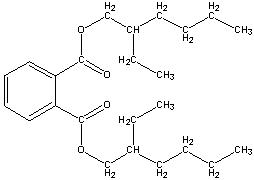
NTP Study Reports

NTP Study Reports
Home » Study Results & Research Projects » NTP Study Reports » All Long-Term Reports » Abstract for TR-217 - Di(2-Ethylhexyl)Phthalate

| Chemical Formula: C24H38O4 | - | 3D Structure* |
|---|---|---|
| *To view structure, download free Chemscape Chime Plug-in | ||
A bioassay of di(2-ethylhexyl)phthalate, the most commonly used plasticizer for polyvinylchloride polymers, for possible carcinogenicity was conducted by feeding diets containing 6,000 or 12,000 ppm of the test chemical to groups of 50 male and 50 female F344 rats and 3,000 or 6,000 ppm to groups of 50 male and 50 female B6C3F1 mice for 103 weeks. Controls consisted of 50 untreated rats and 50 untreated mice of either sex.
Mean body weights of dosed male rats (high- and low-dose), high-dose female rats, and dosed female mice (high- and low-dose) were marginally-to-moderately lower than those of the corresponding controls at the end of the chronic study, reflecting a decrease in body weight gain. Food consumption was reduced slightly in rats of either sex, whereas there was no apparent difference among the mouse groups.
Female rats and male and female mice administered di(2-ethylhexyl)phthalate had significantly higher incidences of hepatocellular carcinomas than those observed in the controls (rats -- males: 1/50, 2%; 1/49, 2%; 5/49, 10%; females -- 0/50, 0%; 2/49, 4%; 8/50, 16%, P=0.003; mice -- males: 9/50, 18%; 14/48, 29%; 19/50, 38%, P=0.022; females: 0/50, 0%; 7/50, 14%; P=0.006, 17/50, 34%, P<0.001). Further, a statistically significant positive trend for hepatocellular carcinomas occurred in female rats (P=0.002) and in male (P=0.018) and female (P<0.001) mice.
In addition, di(2-ethylhexyl)phthalate caused a statistically significant increased incidence of male rats with either hepatocellular carcinomas or neoplastic nodules (3/50, 6%; 6/49, 12%; 12/49, 24%; P=0.010).
Degeneration of the seminiferous tubules was observed in the high-dose male rats (1/49, 2%; 2/44, 5%; 43/48, 90%) and in the high-dose male mice (1/49, 2%; 2/48 4%; 7/49, 14%). Hypertrophy of cells in the anterior pituitary was also found at increased incidences in the high-dose male rats (1/46, 2%; 0/43, 0%; 22/49, 45%).
Under the conditions of this bioassay, di(2-ethylhexyl)phthalate was carcinogenic for F344 rats and B6C3F1 mice, causing increased incidences of female rats and male and female mice with hepatocellular carcinomas, and inducing an increased incidence of male rats with either hepatocellular carcinomas or neoplastic nodules.
Levels of Evidence of Carcinogenicity: | ||
| Male Rats: | Positive | |
| Female Rats: | Positive | |
| Male Mice: | Positive | |
| Female Mice: | Positive | |
Synonym: DEHP
Report Date: March 1982
Target Organs & Incidences from 2-year Studies
You may link to the full technical report in pdf format ( Note: A print ready copy of the document is presented in Portable Document Format (pdf) which requires the Acrobat Reader plug-in -- download a free copy of the reader.)
Web page last updated on October 14, 2004
The National Institute of Environmental Health Sciences is one of the National Institutes of Health within the U.S. Department of Health and Human Services. The National Toxicology Program is headquartered on the NIEHS campus in Research Triangle Park, NC.